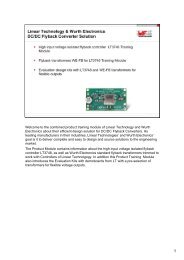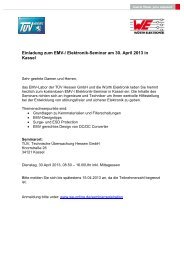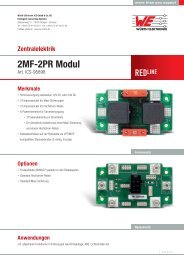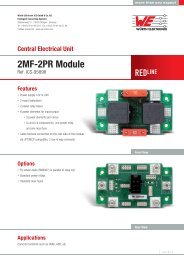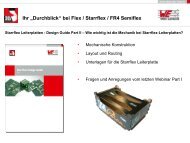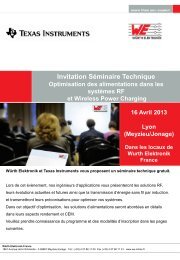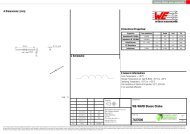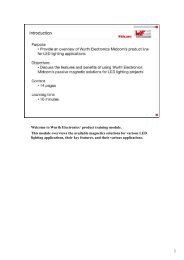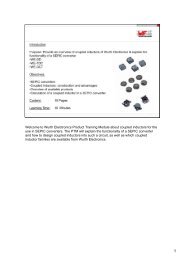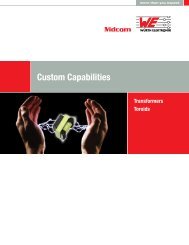Welcome to the Würth Elektronik WE-PDF Flatwire Inductor product ...
Welcome to the Würth Elektronik WE-PDF Flatwire Inductor product ...
Welcome to the Würth Elektronik WE-PDF Flatwire Inductor product ...
Create successful ePaper yourself
Turn your PDF publications into a flip-book with our unique Google optimized e-Paper software.
<strong>Welcome</strong> <strong>to</strong> <strong>the</strong> <strong>Würth</strong> <strong>Elektronik</strong> <strong>WE</strong>-<strong>PDF</strong> <strong>Flatwire</strong> Induc<strong>to</strong>r <strong>product</strong><br />
training module. This module will overview <strong>the</strong> available <strong>product</strong>s, explain<br />
<strong>the</strong> key features and technical background, show cus<strong>to</strong>mers <strong>the</strong><br />
advantages of using a flatwire and last but not least, discuss <strong>the</strong>ir main<br />
applications.<br />
1
<strong>Würth</strong> <strong>Elektronik</strong> has recently released <strong>the</strong> <strong>WE</strong>-<strong>PDF</strong> series of high<br />
performance flatwire induc<strong>to</strong>rs. It is available in two different sizes, 10mm<br />
x 10mm x 4mm and 10mm x 10mm x 6mm. The <strong>WE</strong>-<strong>PDF</strong> consists of a<br />
ferrite material which has significantly lower core losses than iron powder<br />
induc<strong>to</strong>rs and is mainly used in high current induc<strong>to</strong>r designs. The <strong>WE</strong>-<br />
<strong>PDF</strong> series is optimized for power supplies running high switching<br />
frequencies. In particular by using a flatwire construction, <strong>the</strong> frequency<br />
dependent resistance of <strong>the</strong> wire is significantly lower than using a<br />
roundwire. Due <strong>to</strong> <strong>the</strong> focus on high performance partial components for<br />
<strong>the</strong> design, <strong>the</strong> <strong>WE</strong>-<strong>PDF</strong> series has been released for an extended<br />
temperature range up <strong>to</strong> 150 degrees Celsius.<br />
2
The <strong>WE</strong>-<strong>PDF</strong> series is suitable for applications with switching frequencies<br />
up <strong>to</strong> 10MHz such as <strong>the</strong> new generation of high frequency switching<br />
regula<strong>to</strong>rs. The maximum operating temperature of <strong>the</strong> <strong>WE</strong>-<strong>PDF</strong> series is<br />
150°C and it can handle continuous DC currents of up <strong>to</strong> 10.3A.<br />
Additionally, due <strong>to</strong> <strong>the</strong> design and material, this series has a saturation<br />
current of up <strong>to</strong> 30A.<br />
3
<strong>Flatwire</strong> in an induc<strong>to</strong>r design is much more efficient than using roundwire.<br />
The reason for this will be explained in <strong>the</strong> next six slides. In general, it<br />
can be said that <strong>the</strong> whole amount of losses of an induc<strong>to</strong>r are created by<br />
copper losses and core losses. The copper losses depend on resistance,<br />
both DC and AC. While <strong>the</strong> DC resistance is a stable value, <strong>the</strong> AC<br />
resistance is frequency dependent and based on <strong>the</strong> Skin and Proximity<br />
Effect. The AC-resistance will increase with an increase of <strong>the</strong> frequency.<br />
Core losses will not be discussed here as <strong>the</strong> wire type has no influence<br />
on <strong>the</strong> core losses.<br />
4
Most people do NOT consider <strong>the</strong> AC resistance because <strong>the</strong> most<br />
common assumption is that ONLY <strong>the</strong> DC resistance determines <strong>the</strong><br />
copper losses. As a result of this assumption, target number one would be<br />
<strong>to</strong> increase <strong>the</strong> diameter of <strong>the</strong> copper wire <strong>to</strong> increase <strong>the</strong> cross section.<br />
An increase of <strong>the</strong> cross section results in a reduction of DCR and lower<br />
copper losses.<br />
5
There are different ways <strong>to</strong> obtain target number one. The diameter of <strong>the</strong><br />
wire itself can be increased or multiple wires in parallel could be used<br />
instead. Using multiple wires in parallel is nothing else than switching<br />
multiple DC resistances in parallel, which will result in a much lower overall<br />
DCR. Now, by pointing out that multiple wires in parallel and in<br />
particular in a row can be used, it can be seen that <strong>the</strong>re is still room<br />
between <strong>the</strong> wires <strong>to</strong> fulfill <strong>the</strong> winding window exactly. Instead of using a<br />
bunch of roundwires, a flatwire can be used. The outer dimensions, in this<br />
example of four roundwires or one flatwire, will be <strong>the</strong> same. However, by<br />
using a flatwire, <strong>the</strong> entire possible area can be used resulting in a much<br />
lower DCR.<br />
6
This slide will focus on <strong>the</strong> frequency dependent AC resistance. Because<br />
of eddy currents in <strong>the</strong> wire, which is a result of <strong>the</strong> AC-current, <strong>the</strong> current<br />
will be pushed <strong>to</strong> <strong>the</strong> outside skin of <strong>the</strong> wire. This effectively results in a<br />
reduction of <strong>the</strong> area that current can flow. Pointing out <strong>the</strong> equation of <strong>the</strong><br />
skin depth, <strong>the</strong> higher <strong>the</strong> frequency <strong>the</strong> lower <strong>the</strong> skin depth. Coming<br />
back <strong>to</strong> <strong>the</strong> equation of calculating <strong>the</strong> resistance of a wire, <strong>the</strong> smaller <strong>the</strong><br />
conductive surface, <strong>the</strong> higher <strong>the</strong> resistance. Since this resistance will<br />
only appear when driving an AC-current through wire, like <strong>the</strong> ripple<br />
current in a switch mode power supply, this resistance is called ACresistance.<br />
7
The Proximity Effect increases <strong>the</strong> AC-resistance as well. A current driven<br />
wire creates a magnetic field around <strong>the</strong> wire which also creates eddy<br />
currents. By using two wires in parallel, <strong>the</strong> magnetic field of both wires<br />
influence <strong>the</strong> eddy currents resulting in <strong>the</strong> current not being pushed <strong>to</strong> <strong>the</strong><br />
entire skin of <strong>the</strong> wire. This causes <strong>the</strong> proximity effect <strong>to</strong> increase which<br />
results in a much higher AC resistance. To summarize, <strong>the</strong> higher <strong>the</strong><br />
frequency, <strong>the</strong> smaller <strong>the</strong> AC current driven surface, <strong>the</strong> larger <strong>the</strong> AC<br />
resistance. The higher <strong>the</strong> AC resistance, <strong>the</strong> higher <strong>the</strong> copper losses. To<br />
somewhat mitigate this problem, <strong>the</strong> <strong>WE</strong>-<strong>PDF</strong> uses a flatwire where <strong>the</strong><br />
AC copper losses are minimized in comparison <strong>to</strong> induc<strong>to</strong>rs using one or<br />
multiple roundwires.<br />
8
The AC resistance of an induc<strong>to</strong>r is sometimes called Equivalent Series<br />
Resistance. This is <strong>the</strong> resistance in <strong>the</strong> equivalent circuit of an induc<strong>to</strong>r<br />
which represents <strong>the</strong> copper losses with an increase of frequency.<br />
9
From <strong>the</strong> physical point of view, considering <strong>the</strong> same cross section of a<br />
flatwire and a roundwire, e.g. 10mm², <strong>the</strong> flatwire can offer about 20%<br />
more surface area. Because of <strong>the</strong> fact that high frequency currents only<br />
use <strong>the</strong> surface due <strong>to</strong> <strong>the</strong> skin and proximity effects, <strong>the</strong> <strong>WE</strong>-<strong>PDF</strong> flatwire<br />
induc<strong>to</strong>r can offer a higher performance <strong>to</strong> an application by using a<br />
different type of wire.<br />
10
This page summarizes <strong>the</strong> advantage of using <strong>the</strong> flatwire induc<strong>to</strong>r <strong>WE</strong>-<br />
<strong>PDF</strong> series. The flatwire uses <strong>the</strong> whole winding window, maximizing <strong>the</strong><br />
available area on <strong>the</strong> core <strong>to</strong> reach <strong>the</strong> minimum DCR possible. Secondly,<br />
by using <strong>the</strong> flatwire, <strong>the</strong> AC resistance is much lower than that of<br />
roundwire induc<strong>to</strong>r designs.<br />
11
This page shows an extract of <strong>the</strong> typical applications for <strong>the</strong> <strong>WE</strong>-<strong>PDF</strong><br />
<strong>Flatwire</strong> induc<strong>to</strong>r series.<br />
12
Additionally, Wurth would like <strong>to</strong> point out that <strong>the</strong> <strong>WE</strong>-<strong>PDF</strong> flatwire<br />
induc<strong>to</strong>r is rated up <strong>to</strong> 150°C. Also, <strong>the</strong> component series <strong>WE</strong>-<strong>PDF</strong> is<br />
designed for a high degree of robustness and for use in adverse<br />
environmental conditions or o<strong>the</strong>r extreme conditions that exceed <strong>the</strong><br />
ratings of standard components<br />
13
The <strong>WE</strong>-<strong>PDF</strong> series is available in <strong>the</strong> package sizes 10mm x 10mm x<br />
4.5mm and 10mm x 10mm x 6.4mm. Each package size carries a broad<br />
range of inductance values <strong>to</strong> provide <strong>the</strong> optimum solution for a<br />
cus<strong>to</strong>mer‘s application. All values are in s<strong>to</strong>ck and available from Digikey.<br />
14
The Wurth Electronics <strong>WE</strong>-HC/<strong>WE</strong>-HCA series is also equipped with Flat<br />
Wire and delivers <strong>the</strong> performance users need in <strong>the</strong>ir power supply. The<br />
available core materials are Superflux and <strong>WE</strong>-PERM which<br />
characteristically have low core losses and high saturation currents. The<br />
HC series parts are available in ei<strong>the</strong>r a 7mm x 7mm or 10mm x 10mm<br />
package size and are rated up <strong>to</strong> 150°C.<br />
15
In addition, Wurth Electronics carries <strong>the</strong> <strong>WE</strong>-HCA series which is<br />
available in 13mm x 13mm package size and three different profiles. The<br />
maximum saturation current is rated at 65A and <strong>the</strong> 13mm x 13mm parts,<br />
which often are used in high temperature applications, are rated at up <strong>to</strong><br />
150°C. The <strong>WE</strong>-HCB series is <strong>the</strong> largest family of <strong>Flatwire</strong> Induc<strong>to</strong>rs<br />
manufactured by Wurth Electronics. With its 18mm x 18mm package and<br />
outstanding current handling capabilities it is <strong>the</strong> <strong>to</strong>p of <strong>the</strong> line <strong>product</strong> for<br />
high current DC/DC converters without external cooling. The parts have a<br />
temperature rating of up <strong>to</strong> 125°C. All <strong>product</strong>s of <strong>the</strong> Wurth Electronics<br />
<strong>WE</strong>-<strong>PDF</strong>, <strong>WE</strong>-HC, <strong>WE</strong>-HCA and <strong>WE</strong>-HCB lines are available in s<strong>to</strong>ck at<br />
www.digikey.com.<br />
16
In summary, <strong>the</strong> <strong>WE</strong>-<strong>PDF</strong> series from Wurth Electronics Midcom can<br />
increase, with Flat Wire Technology, <strong>the</strong> efficiency of a given application.<br />
The series is available in a low profile 1045 package along with <strong>the</strong><br />
standard 1064 size.<br />
17



